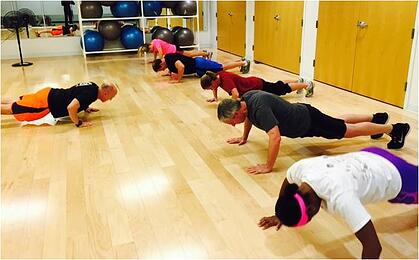 Staying hydrated is an important part of staying healthy and functional during everyday life. Proper hydration helps the body perform several crucial functions including regulating body temperature, keeping joints lubricated, delivering nutrients to cells, and keeping organs functioning properly. Quality hydration also helps to improve quality of sleep, cognitive function, and general mood. Considering all the functions that hydration helps to maintain it’s important to ask a few questions: How much fluid to we need to consume and what are some sources to get it from?
Staying hydrated is an important part of staying healthy and functional during everyday life. Proper hydration helps the body perform several crucial functions including regulating body temperature, keeping joints lubricated, delivering nutrients to cells, and keeping organs functioning properly. Quality hydration also helps to improve quality of sleep, cognitive function, and general mood. Considering all the functions that hydration helps to maintain it’s important to ask a few questions: How much fluid to we need to consume and what are some sources to get it from?
According to the Mayo Clinic men should consume 15.5 cups of fluid per day and women should consume 11.5 cups of fluid per day. When people see those numbers, their minds immediately go to liquids: water, sports drinks, tea, etc. Water is an excellent and very popular source of liquid to maintain hydration. Sports drinks can also be very effective, particularly during or after lengthy, strenuous exercise. Even tea can be an effective hydrator when consumed in moderate amounts. As effective as these liquids are, they are not the only quality sources of hydration in our diet. In fact, about 20% of fluid is obtained through foods with high water content. There is a plethora of foods, particularly fruits and vegetables, that can help keep you hydrated throughout the day.
There are several great fruit options to help you stay hydrated. Watermelon might be the most famous and effective example. With a 92% water content is one of the most hydrating foods you can eat. It also is very low in calorie density which makes a good snack for weight loss or weight maintenance. Cantaloupe is another fruit that really packs a hydration punch. It has a 90% water content and Vitamin A which can boost immune health. You can also add cantaloupe to salads, smoothies or even yogurt to help hydrate while eating a meal. Other fruits that can be great for hydration include peaches, strawberries, and oranges. Not only do each of these fruits help with hydration but also provide other nutritional value.
Vegetables can also be a great source of hydration in everyday life. Iceberg lettuce is an excellent example of a veggie that help with hydration. It is also easy to a dd into your diet by making salads. Additionally, it contains fiber, vitamins A and K, and potassium which adds some good nutritional value. Zucchini is also a great way to help hydrate. It has a very high-water content and is also low in calories. Furthermore, it provides a lot of diet versatility, meaning you can eat it as is or add it to something larger. It works well on its own but can also be incorporate into soups, stir-fries, or other side dishes. Celery, Cucumbers and Tomato can also be very valuable sources of hydration outside of liquid. Each provide their own nutritional value whether it be antioxidants or valuable vitamins.
Staying hydrated is a vital part of maintaining your everyday health and well-being. As such it is important to know all the sources of hydration that are out there. Water, tea, milk, and other liquids are great options to stay hydrated but it’s important to know alternative sources. Incorporating water rich fruits and veggies into your diet can make it easier and tastier to stay hydrated throughout the year!


 NIFS isn't the only agency that provides fitness management expertise to businesses. There are several like us because the market demands it. While many organizations have adopted a DIY attitude about managing their own fitness programs, an additional (and substantial) set of businesses has recognized the value in outsourcing fitness center management for their corporate fitness center or in their senior living community.
NIFS isn't the only agency that provides fitness management expertise to businesses. There are several like us because the market demands it. While many organizations have adopted a DIY attitude about managing their own fitness programs, an additional (and substantial) set of businesses has recognized the value in outsourcing fitness center management for their corporate fitness center or in their senior living community.
 Businesses need top performers in order to survive. We need sales staff who are heavy hitters, research staff who are actually rocket scientists, and customer service professionals who can turn any frown upside down. You know who those folks are in your organization, that top 5% of all performers. In some cases, they might be unsung heroes, but at a lot of businesses, the best among us are often publically lauded. They are the elite.
Businesses need top performers in order to survive. We need sales staff who are heavy hitters, research staff who are actually rocket scientists, and customer service professionals who can turn any frown upside down. You know who those folks are in your organization, that top 5% of all performers. In some cases, they might be unsung heroes, but at a lot of businesses, the best among us are often publically lauded. They are the elite.
 My earliest memory of my biggest fear was around age seven or eight. I was playing in my backyard with my childhood best friend on the swing set. We were running around it trying to catch each other when I slipped and fell, cutting my arm. I didn’t even realize I was bleeding until my friend pointed it out to me. Immediately my heart started to race, palms began to sweat, and I quickly lost all the color in my face. The next thing I remember is my Mom and friend standing over me as I lay on the ground after passing out. Every encounter with blood after this episode only amplified this fear, often resulting in avoiding certain situations such as routine blood draws or even jobs that required me to be able to perform a finger stick cholesterol test to fitness center members. Finally, after living with this fear for over twenty years, I finally made up my mind that it was time to face it. What is the one big fear you have in your life? Are you ready to face it?
My earliest memory of my biggest fear was around age seven or eight. I was playing in my backyard with my childhood best friend on the swing set. We were running around it trying to catch each other when I slipped and fell, cutting my arm. I didn’t even realize I was bleeding until my friend pointed it out to me. Immediately my heart started to race, palms began to sweat, and I quickly lost all the color in my face. The next thing I remember is my Mom and friend standing over me as I lay on the ground after passing out. Every encounter with blood after this episode only amplified this fear, often resulting in avoiding certain situations such as routine blood draws or even jobs that required me to be able to perform a finger stick cholesterol test to fitness center members. Finally, after living with this fear for over twenty years, I finally made up my mind that it was time to face it. What is the one big fear you have in your life? Are you ready to face it? 
 In
In  We sit. Frankly, we sit a lot. We sit at home, we sit on our commutes, we sit at work, we sit during our child’s after-school activities. Sit, sit, sit. And it’s not doing us any favors, either. In fact, recent startling statistics indicate that sitting may be a significant threat to our overall wellbeing.
We sit. Frankly, we sit a lot. We sit at home, we sit on our commutes, we sit at work, we sit during our child’s after-school activities. Sit, sit, sit. And it’s not doing us any favors, either. In fact, recent startling statistics indicate that sitting may be a significant threat to our overall wellbeing.




 We don’t really know how other management companies do what they do for their clients; corporate fitness services aren’t easy to secret shop. But we are great at what we do – we’ve got the satisfaction survey feedback and
We don’t really know how other management companies do what they do for their clients; corporate fitness services aren’t easy to secret shop. But we are great at what we do – we’ve got the satisfaction survey feedback and